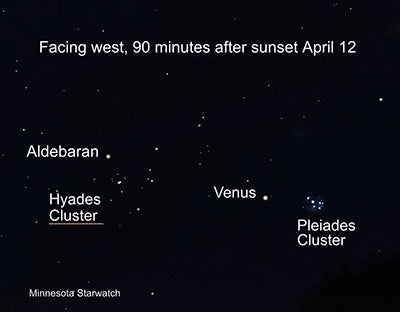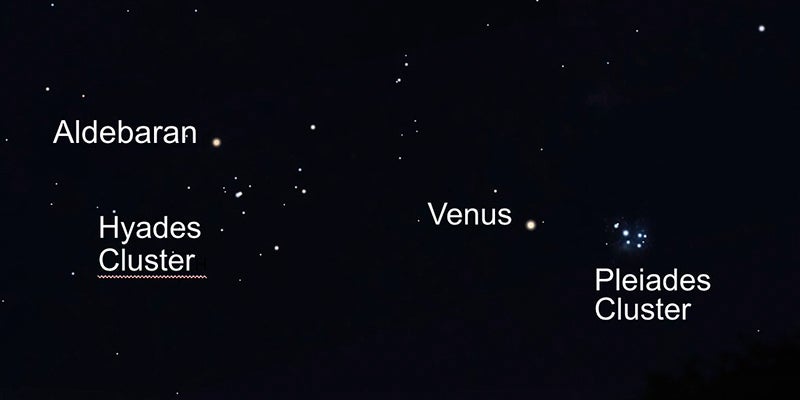Minnesota StarWatch: Venus chases Mars
Published 6:59 pm Tuesday, March 28, 2023
|
Getting your Trinity Audio player ready...
|
By Deane Morrison
Venus spends April chasing Mars, but — spoiler alert — won’t catch up to the red planet. At least not anytime soon.
Our sister planet is an unmistakable “evening star” in the west. Meanwhile, Mars sojourns through the Gemini twins as the bright winter stars stream past it toward the sunset. Nightfall in mid-month will be the last good time this season to compare Venus to Sirius, the brightest of stars, which will be low in the southwest.

Graphic provided
Watch the Pleiades star cluster slip by Venus between Sunday, the 9th and Wednesday, the 12th. Just east of Venus, look for the V-shaped Hyades cluster, which forms the face of Taurus, the bull. The bull’s eye is the bright star Aldebaran, which is not part of the Hyades.
The spring constellation Leo, the lion, reaches its highest point in the south at nightfall this month. Look for the backward question mark of stars outlining Leo’s head. This figure, called the Sickle, is anchored by bright Regulus, the lion’s heart. The lion’s hindquarters are a triangle of stars pointing eastward. On moonless nights, grab a star chart and binoculars and try to spot the lovely but subdued Beehive star cluster between Regulus and Pollux, the brighter of the Gemini twins.
In the northeast, the Big Dipper balances on its handle at nightfall. Follow the curve of the handle to Arcturus, the brightest star in the northern hemisphere of sky. Its kite-shaped constellation, Bootes, the herdsman, is a pleasing staple of the summer night sky.
Watch for a somewhat bright star to climb over the southeastern horizon to the lower right of Arcturus. This is Spica, the only landmark in large but dim Virgo, the maiden. To the west of Spica you’ll find the irregular four-sided figure of Corvus, the crow.
April’s full moon arrives at 11:34 p.m. on Wednesday, the 5th. That night it leads Spica across the sky.
The University of Minnesota’s public viewings of the night sky at its Duluth and Twin Cities campuses have been curtailed due to the COVID-19 pandemic. For more information, see:
• Duluth, Marshall W. Alworth Planetarium: www.d.umn.edu/planet
• Twin Cities, Minnesota Institute for Astrophysics: www.astro.umn.edu/outreach/pubnight
• Check out astronomy programs, free telescope events, and planetarium shows at the
• University of Minnesota’s Bell Museum: www.bellmuseum.umn.edu/astronomy
• Find U of M astronomers and links to the world of astronomy at: http://www.astro.umn.edu



